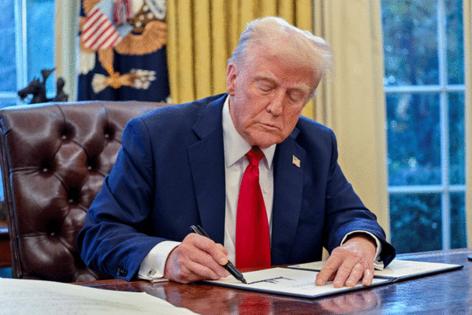Idaho schools activities association bans transgender athletes, changing rule to follow Trump's order
Published in News & Features
BOISE, Idaho — No transgender athlete ever asked Idaho’s high school sports governing body to play for a school’s athletic teams. But the Idaho High School Activities Association conformed with an executive order from President Donald Trump on Wednesday and banned transgender athletes from its girls sports.
During its April board meeting, the IHSAA quietly repealed its 10-year-old rule that allowed a transgender boy or girl to compete under specific circumstances. The 15-member board unanimously repealed it with no discussion, replacing the rule with a statement that says, “Until codified by law, the IHSAA will follow the federal February 5, 2025, executive order.”
“We didn’t want to put member schools in a compromising position where they could lose federal funding,” IHSAA Executive Director Chad Williams said. “The loss of federal funding — it’s a substantial amount for our schools.”
Trump’s executive order reinterpreted federal Title IX law to bar athletes assigned male at birth from participating in female sports. The order threatened to “rescind all funds from educational programs that deprive women and girls of fair athletic opportunities … ”
The order already faces legal challenges. Maine sued the Trump administration Monday for withholding funds to feed schoolchildren over the state’s transgender athlete rules, NBC reported. A pair of transgender teens from New Hampshire also sued in February, according to The Associated Press.
Trump’s executive order continues a back-and-forth over transgender athletes’ place in sports. Idaho was the first state to ban transgender girls and women from female sports in 2020. Courts blocked the law from taking effect while lawsuits continued, citing potential violations of transgender students’ equal protection rights, as well as what U.S. Circuit Judge Kim Wardlaw described as “invasive” medical procedures to determine the sex of female athletes.
Williams and Ty Jones, the previous IHSAA executive director, both confirmed to the Statesman that no transgender athlete ever applied to play an Idaho high school sport under the state’s previous rules.
What did the IHSAA transgender rules say?
The court rulings that came after Idaho’s 2020 law restored the IHSAA’s transgender rules, first established during the 2014-15 school years. The rules allowed transgender athletes to compete as a gender different from the one assigned at birth under the following scenarios:
—An athlete born as a male could compete on a girls team only after taking medically prescribed hormone treatments under a physician’s care for at least a year.
—An athlete born as a female taking medically prescribed hormone treatments must compete on a boys team.
The IHSAA repealed both rules to align with Trump’s executive order, which makes no mention of a female taking male hormone treatments. Williams said the IHSAA currently has no rule to address that scenario. The IHSAA leaves drug policies up to individual schools.
New classification proposal fails
A proposal to add a seventh classification to Idaho high school sports failed to move forward during Wednesday’s meeting, pushing any possible changes until at least the 2028-29 school year.
The IHSAA’s classification committee presented a plan to add an additional classification and change how Idaho places schools in divisions. Instead of dividing schools by predetermined enrollment figures, the plan would rank schools by enrollment and then group them together.
For example, it would place the 18 largest schools by enrollment in 7A; the next 18 largest in 6A; and the following 18 in 5A. The 4A and 3A classifications would each have 22 teams ranked by enrollment, with 2A and 1A splitting the remaining schools at 30 each.
That differs from the current system, where any school with more than 1,400 students belongs in the largest classification, regardless of how many of those schools Idaho has.
Tol Gropp, the committee chair, said the plan would evenly distribute schools among classifications and increase the number of athletes that compete in a state tournament. But he noted Idaho’s uneven distribution of schools meant some teams might have to face an opponent more than twice their enrollment, a violation of a long-held guideline for Idaho classifications.
The proposal said Idaho has 39 schools with more than 1,000 students and 120 schools with 500 or fewer. But it has only 16 schools with 500 to 1,000 students.
Idaho just changed its classification system last fall, its first major redo in 20 years. It renamed its divisions and adjusted the enrollment boundaries for all six classifications.
_____
©2025 The Idaho Statesman. Visit idahostatesman.com. Distributed by Tribune Content Agency, LLC.







Comments